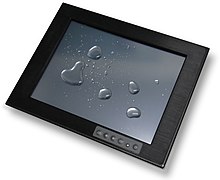
Back علامة الحماية العالمية Arabic IP standartı Azerbaijani IP-код BE-X-OLD Grau de protecció IP Catalan Stupeň krytí Czech IP-koden Danish Schutzart German Grado de protección IP Spanish IP-kood Estonian درجه حفاظت Persian


The IP code or ingress protection code indicates how well a device is protected against water and dust. It is defined by the International Electrotechnical Commission (IEC) under the international standard IEC 60529[1] which classifies and provides a guideline to the degree of protection provided by mechanical casings and electrical enclosures against intrusion, dust, accidental contact, and water. It is published in the European Union by the European Committee for Electrotechnical Standardization (CENELEC) as EN 60529.
The standard aims to provide users more detailed information than vague marketing terms such as waterproof. For example, a cellular phone rated at IP67 is "dust resistant" and can be "immersed in 1 meter of freshwater for up to 30 minutes". Similarly, an electrical socket rated IP22 is protected against insertion of fingers and will not become unsafe during a specified test in which it is exposed to vertically or nearly vertically dripping water. IP22 or IP2X are typical minimum requirements for the design of electrical accessories for indoor use.[2]
The digits indicate conformity with the conditions summarized in the tables below. The digit 0 is used where no protection is provided. The digit is replaced with the letter X when insufficient data has been gathered to assign a protection level. The device can become less capable; however, it cannot become unsafe.
There are no hyphens in a standard IP code. IPX-8 (for example) is thus an invalid IP code.[3]
- ^ "IEC 60529:1989+AMD1:1999+AMD2:2013 CSV | IEC Webstore | water management, smart city, rural electrification". webstore.iec.ch. Retrieved 8 May 2024.
- ^ "IP Rating - Ingress Protection Explained | Tansun". www.tansun.com. Retrieved 8 May 2024.
- ^ Cite error: The named reference
NE Laserwas invoked but never defined (see the help page).